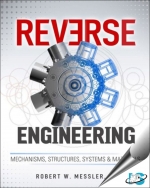Tab Article
A comprehensive look at reverse engineering as a legitimate learning, design, and troubleshooting tool
This unique book examines the often underappreciated and occasionally maligned technique of reverse engineering. More than a shortcut for the lazy or unimaginative to reproduce an artless copy of an existing creation, reverse engineering is an essential brick – if not a keystone – in the pathway to a society’s technological advancement.
Written by an engineer who began teaching after years in industry, Reverse Engineering reviews this meticulous analytical process with a breadth and depth as never before. Find out how to:
- Learn by “mechanical dissection”
- Deduce the role, purpose, and functionality of a designed entity
- Identify materials-of-construction and methods-of-manufacture by observation alone
- Assess the suitability of a design to purpose from form and fit
The rich heritage of engineering breakthroughs enabled by reverse engineering is also discussed. This is not a dry textbook. It is the engaging and enlightening account of the journey of engineering from the astounding creations of ancient cultures to what, with the aid of reverse engineering, promises to be an even more astounding future!
Coverage includes:
- Methods of product teardown
- Failure analysis and forensic engineering
- Deducing or inferring role, purpose, and functionality during reverse engineering
- The Antikythera mechanism
- Identifying materials-of-construction
- Inferring methods-of-manufacture or -construction
- Construction of Khufu’s pyramid
- Assessing design suitability
- Value and production engineering
- Reverse engineering of materials and substances
- Reverse engineering of broken, worn, or obsolete parts for remanufacture
- The law and the ethics of reverse engineering


